George Grosz
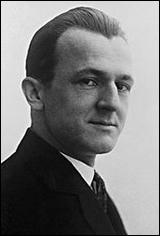
Georg Ehrenfried Grosz, the son of a pub owner, was born in Berlin, Germany, on 26th July, 1893. He was brought up by devout Lutheran parents. His father was warden at the local masonic hall. "My father himself used sometimes to draw on the large cardboard sheets pinned to the square table... I can still remember sitting on his lap and watching all sorts of creatures come to life under his hand." (1)
His father died in 1901 and the family moved to Berlin. "My mother and aunt sewed blouses for some big concern - hard work that brought in little cash. True, living was cheap, and we had enough of the bare necessities, but we were constantly beset by money worries now.... We were living in a real working-class district, though I did not realize it at the time." (2)
Grosz was a talented artist and began attending a weekly drawing class taught by a local painter. In 1909 he became a student at the Dresden Academy of Fine Arts, where his teachers were Robert Sterl and Osmar Schindler. In 1911 he moved to the Berlin College of Arts and Crafts where he studied under Emil Orlik. (3) During this period Grosz had his first caricatures published in the Berliner Tageblatt. (4)
On the outbreak of the First World War Grosz was conscripted into the German Army. "What can I say about the First World War, a war in which I served as an infantryman, a war I hated at the start and to which I never warmed as it proceeded? I had grown up in a humanist atmosphere, and war to me was never anything but horror, mutilation and senseless destruction, and I knew that many great and wise people felt the same way about it. At the outbreak of hostilities, Germany was in the throes of a kind of mass delirium, but when the first flush of that was over there was nothing to take its place." (5)
A strong opponent of the war, he was eventually released as unfit for duty. Grosz wrote to a friend "The time I spent in the stranglehold of militarism was a period of constant resistance - and I know there was not one thing I did which did not utterly disgust me... I have one dream: perhaps there will, after all, be changes, rebellions, perhaps one day international socialism which has lost its backbone will gather strength enough for an open uprising... It is an absurd dream, no more... to the slaughterhouse!" (6)
However, the following year, desperate for soldiers, Grosz was called up again. Kept from frontline action, Grosz was used to transport and guard prisoners of war. "In 1916 I was discharged from military service, or rather, given a sort of leave of absence on the understanding that I might be recalled within a few months. And so I was a free man, at least for a while. The collapse of Germany was only a matter of time. All the fine phrases were now no more than stale, rank printer's in on brown substitute paper. I watched it all from my studio in Sudende, living and drawing in a world of my own. I drew soldiers without noses; war cripples with crab-like limbs of steel; two medical orderlies tying a violent infantryman up in a horse blanket; a one-armed soldier using his good hand to salute a heavily bemedalled lady who had just passed him a biscuit; a colonel, his fly wide open, embracing a nurse; a hospital orderly emptying a bucket full of pieces of human flesh down a pit." (7)
George Grosz and Nationalism
Grosz hated the strong nationalism that had emerged during the war in Germany. Grosz's close friend, the artist, Helmut Herzfeld, shared this view and decided to change his name to John Heartfield in 1916 in "protest against German nationalistic fervour". (8) Grosz decided to follow his example changed the spelling of his name to "de-Germanise" and internationalise his name – thus Georg became "George". (9)
In the middle of 1917 Grosz was recalled to the German Army. "My new duties were to train recruits and to transport and guard prisoners of war. But I had enough and one night they found me semi-conscious, head-first in the latrine. I spent some time in hospitals after that. Whenever I had a moment to spare I would vent my spleen in sketches of everything about me that I hated, either in my notebook or on sheets of writing paper; the brutal faces of my comrades, badly mutilated war cripples, arrogant officers, lascivious nurses." (10)
Grosz had joined the Spartacus League, an anti-war organization, led by Karl Liebknecht and Rosa Luxemburg. He now considered himself a Marxist and a pacifist. He was terribly unhappy in the army and in 1917 he tried to commit suicide and Grosz was placed in an army hospital. According to Grosz, it was decided to execute him but he was saved by the intervention of one of his wealthy patrons, Count Harry Clemens Ulrich Kessler. Grosz was now diagnosed as suffering from shell-shock and was discharged from the German Army. (11)
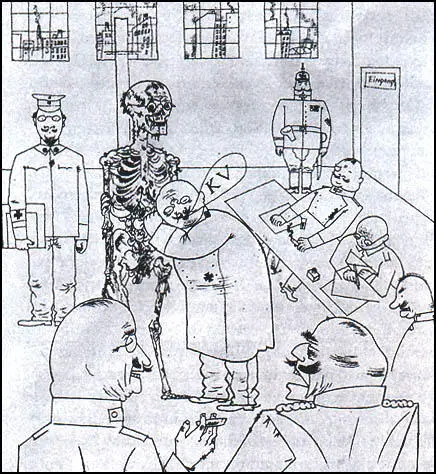
The war had a major impact on his art. Grosz joined with John Heartfield in protesting about the German wartime propaganda campaign against the allies. He was also totally opposed to the war continuing when it was clear that victory was impossible. His most powerful anti-war drawings during this period, was such Fit for Active Service (1918), in which a well-fed doctor inspecting a skeleton with an ear trumpet and pronouncing a skeleton, "KV" fit for duty. Unconcerned with the diagnosis, the surrounding officers appear either bored or absorbed in other matters. (12)
The German Revolution
The German government of Max von Baden asked President Woodrow Wilson for a cease-fire on 4th October, 1918. "It was made clear by both the Germans and Austrians that this was not a surrender, not even an offer of armistice terms, but an attempt to end the war without any preconditions that might be harmful to Germany or Austria." This was rejected and the fighting continued. On 6th October, it was announced that Karl Liebknecht, who was still in prison, demanded an end to the monarchy and the setting up of Soviets in Germany. (13)
By the 8th November, workers councils took power in virtually every major town and city in Germany. This included Bremen, Cologne, Munich, Rostock, Leipzig, Dresden, Frankfurt, Stuttgart and Nuremberg. Theodor Wolff, writing in the Berliner Tageblatt: "News is coming in from all over the country of the progress of the revolution. All the people who made such a show of their loyalty to the Kaiser are lying low. Not one is moving a finger in defence of the monarchy. Everywhere soldiers are quitting the barracks." (14)
On 7th November, 1918, Kurt Eisner, a member of the Independent Social Democratic Party (USPD) established a Socialist Republic in Bavaria. Several leading socialists arrived in the city to support the new regime. This included Erich Mühsam, Ernst Toller, Otto Neurath, Silvio Gesell and Ret Marut. Eisner also wrote to Gustav Landauer inviting him to Munich: "What I want from you is to advance the transformation of souls as a speaker." Landauer became a member of several councils established to both implement and protect the revolution. (15)
Konrad Heiden wrote: "On November 6, 1918, he (Kurt Eisner) was virtually unknown, with no more than a few hundred supporters, more a literary than a political figure. He was a small man with a wild grey beard, a pince-nez, and an immense black hat. On November 7 he marched through the city of Munich with his few hundred men, occupied parliament and proclaimed the republic. As though by enchantment, the King, the princes, the generals, and Ministers scattered to all the winds." (16)
George Grosz was a supporter of the German Revolution. Grosz was especially hostile to Friedrich Ebert, the leader of the German Social Democrat Party, and the leader of the government. "President Ebert had his beard trimmed, looked more and more like a managing director and changed his democratic felt hat for a shiny topper. Secretary of State Otto Meissner, the republic's master of ceremonies, made sure that he performed the office of his illustrious predecessors with due dignity and did not commit too many proletarian solecisms in the pursuit of his exalted duties." (17)
The Spartacus League published a leaflet that claimed: "The Ebert-Scheidemann government intends, not only to get rid of the last representative of the revolutionary Berlin workers, but to establish a regime of coercion against the revolutionary workers." It is estimated that over 100,000 workers demonstrated against the sacking of Eichhorn the following Sunday in "order to show that the spirit of November is not yet beaten." (18)
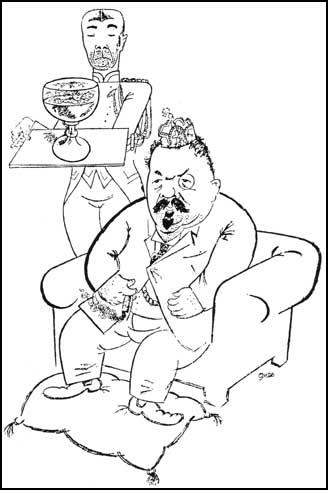
By 13th January, 1919 the rebellion had been crushed and most of its leaders were arrested. This included Rosa Luxemburg and Karl Liebknecht, who refused to flee the city, and were captured on 16th January and taken to the Freikorps headquarters. "After questioning, Liebknecht was taken from the building, knocked half conscious with a rifle butt and then driven to the Tiergarten where he was killed. Rosa was taken out shortly afterwards, her skull smashed in and then she too was driven off, shot through the head and thrown into the canal." (19)
Friedrich Ebert, the president of Germany, arranged for 30,000 Freikorps, under the command of General Burghard von Oven, to take Munich. At Starnberg, some 30 km south-west of the city, they murdered 20 unarmed medical orderlies. The Red Army knew that the choice was armed resistance or being executed. The Bavarian Soviet Republic issued the following statement: "The White Guards have not yet conquered and are already heaping atrocity upon atrocity. They torture and execute prisoners. They kill the wounded. Don't make the hangmen's task easy. Sell your lives dearly." (20)
Weimar Republic
Grosz explained that the experience of war had a major impact on political consciousness: "Yes, everyone was now allowed his say. But having been used to taking their marching orders for years, all they could do was strut about a little less stiffly perhaps but also less smartly than before. The people obviously missed the sharp voice of command, and as for their vaunted freedom, they were at a complete loss what to do with it. Each one had a political view, compounded of fear, envy and hope - but what good were these views to anyone if no leader came forward to put them into practice? And as the people themselves refused to shoulder the responsibility or the blame, they had to look for a scapegoat. One was ready to hand: the Jew." (21)
Zbyněk Zeman has pointed out in his book, Heckling Hitler: Caricatures of the Third Reich (1984) that Grosz's art was deeply influenced by the political situation: "The brutality and confusion of Germany after World War I were strikingly reflected in George Grosz's drawings. His drawing Communists Fall and Shares Rise refers to Bloody Week (10-17 January 1919) when regular and irregular troops of the Republic crushed the communist 'Spartacists', who had occupied the imperial palace in Berlin." (22)
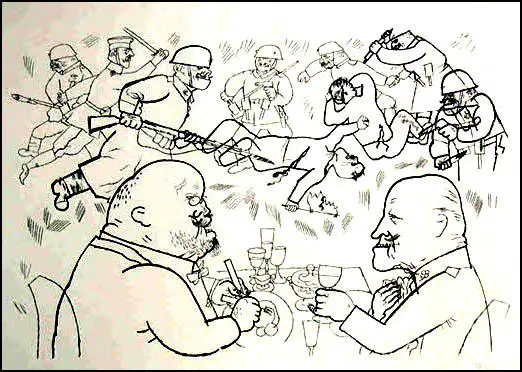
Uwe M. Schneede, the author of George Grosz: His Life and Work (1979) has pointed out that the drawing was inspired by a phrase used by Rosa Luxemburg during the First World War: "Grosz links military action against the workers with the economic interests of the ruling classes. These drawings are comments on the Marxist interpretation of history, made wholly convincing through the powerful characterisation of the facial expressions of those who order the murders and those who carry them out." (23)
George Grosz began contributing work to Die Neue Jugend, an arts journal published by his brother. His work was influenced by his friend, John Heartfield who had "developed a new very amusing style of using collage and bold typography". (24) Grosz helped him develop what became known as photomontage (the production of pictures by rearranging selected details of photographs to form a new and convincing unity). We... invented photomontage in my South End studio at five o'clock on a May morning in 1916, neither of us had any inkling of its great possibilities, nor of the thorny yet successful road it was to take. As so often happens in life, we had stumbled across a vein of gold without knowing it." (25)
In 1920 George Grosz, John Heartfield and Raoul Hausmann organised the Erste Internationale Dada-Messe in the Berlin gallery owned by Otto Burchard. It was a comprehensive manifestation of Dada (a movement consisted of artists who rejected the logic, reason, and aestheticism of modern capitalist society, instead expressing nonsense, irrationality, and anti-bourgeois protest in their works). Among the 174 works in the exhibition were pictures by Grosz, Heartfield, Hausmann, Otto Dix, Max Ernst, Hannah Höch and Rudolf Schlichter. "The text on the panels accompanying each exhibit was partly Dadaist-polemical, partly political." (26)
In 1922 Grosz traveled to the Soviet Union with the Danish writer Martin Andersen Nexø. Upon their arrival in Murmansk they were briefly arrested as spies; after their credentials were approved, they were allowed to meet with Lenin and other revolutionary leaders such as Grigory Zinoviev and Anatoly Lunacharsky. Grosz's six-month stay in the Soviet Union left him unimpressed by what he had seen. (27) On his return he left the KPD, but he remained a committed socialist revolutionary. (28) After spending time in the Soviet Union he could "no longer subscribe to the positive image of the happy, liberated worker". (29)
Grosz wrote in his autobiography about how the political situation had changed the role of the artist: “All moral codes were abandoned. A wave of vice, pornography and prostitution enveloped the whole country.... The streets became ravines of manslaughter and cocaine traffic, marked by steel rods and bloody, broken chair legs.” (30) In 1923 he published the book, Ecce Homo. It contained 84 offset lithographs and 16 watercolor reproductions. "The book is a vicious satire of post-war German life, with politicians, capitalists, prostitutes, mutilated veterans, beggars, and drunks in various states of despair, lust, and rage. The German government banned it and Grosz was put on trial for public offense. While he was clearly influenced by the Cubist, Bauhaus, and Fauvist movements, in Ecce Homo, Grosz’s raw, angry style is distinctly his own." (31)
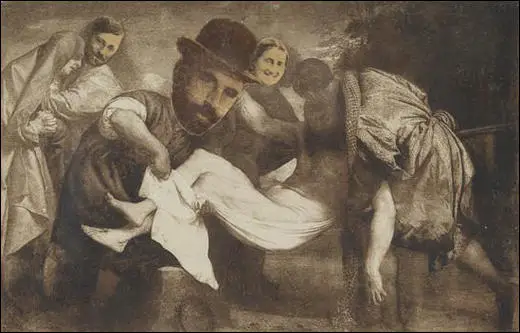
Lisa Small has argued: "Cynicism and disillusionment with the government and militarism permeates the work of George Grosz, an incisive caricaturist, satirist, and one of the most influential graphic artists to be associated with Expressionism, New Objectivity, and Dada. An ardent communist and supporter of the working class, Grosz expressed his disdain for the right wing capitalist and military ruling classes in a caustic portfolio of lithographs he made after WWI ironically titled God With Us after the nationalistic motto inscribed on every German soldier’s belt buckle. The print For German Right and German Morals presents five brutish, malevolent, and corrupt specimens of the German military; the squat and thuggish officer in the center, whose holster makes obvious reference to his genitals, crushes a flower under his boot." (32)
In one case Grosz was charged with blasphemy for his cartoon of Christ in a gas-mask. Mary M. Lane claimed that this was a warning against radical far-right religious views... a work that shows Jesus Christ nailed to the cross wearing combat boots and a gas mask - a criticism of politicizing Christianity that drew praise from pacifist Quakers in the United States." (33)
Frank Whitford has argued that the work of artists such as George Grosz and Otto Dix developed what became known as the New Realism. "They had grown weary of the years of hectic experimentation that had preceded the war and that they were tired of all kinds of art that were highly subjective, metaphysical, esoteric and accessible only to an elite. They wanted to return to subjects that were familiar to everyone, painted in a way which everyone could understand. Some of them were content simply to mirror common experience of mundane things. Others, more politically inspired, preferred to angle the mirror so that the dark side of society was revealed. All of these artists cultivated a painstakingly realistic style which emulated the smooth, anonymous surface of the photograph." (34)
George Grosz gained support from Bertolt Brecht: "Let us suppose that the trial of Socrates is over. We organize a short witches' trial, where the judges are armoured knights who condemn the witch to the stake. Then the trial of George Grosz begins, but we forget to remove the knights from the stage. When the indignant prosecutor storms at the artist for having insulted our mild and compassionate God... the knights... are moved to applause." (35)
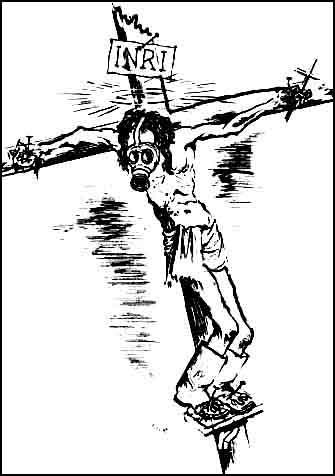
Grosz and John Heartfield joined with Paul Levi, Willie Munzenberg, Clara Zetkin, Ernst Toller, Walther Ulbricht, Heinrich Blücher, Julian Marchlewski, Ernst Thälmann, Hermann Duncker, Hugo Eberlein, Paul Frölich, Wilhelm Pieck, Franz Mehring, and Ernest Meyer. to form the German Communist Party (KPD). Over the next fifteen years Grosz and Heartfield produced designs and posters for the organization. (36) Grosz participated in the First International Dada Fair of 1920. Grosz's collected drawings, The Face of the Ruling Class was published in 1921. It is claimed that Grosz and Heartfield had a major influence on the German Dada group that included Otto Dix, Max Ernst, Raoul Hausmann and Kurt Schwitters. (37)
In 1925 Grosz started painting in oils again. The subject of his first portrait was Max Herrmann-Neisse, a poet and fellow left-wing activist. Herrmann-Neisse became a great supporter of the work of Grosz. He later wrote: "I always felt perfectly at home with George Grosz. We had roughly the same convictions and moods... We were both poets as well as cynics, at once correct and anarchic. I sat for him innumerable times with the greatest of pleasure, feeling blissfully secure in his studio... Leaning against the walls were the pictures which for the decent citizen represented a veritable chamber of horrors. The painstaking way in which he worked on my portrait demonstrated how very seriously he took his work." (38)
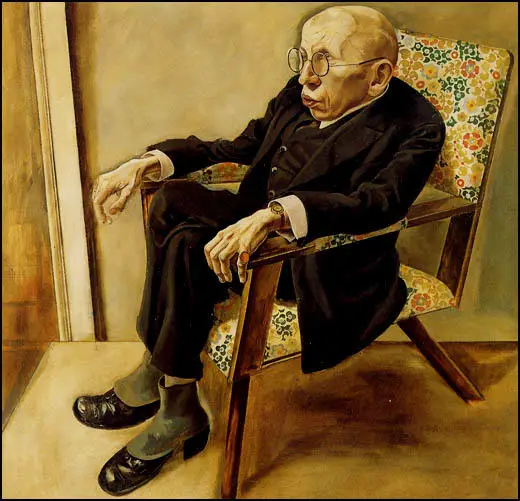
Grosz disliked post-war Germany and the excesses of city life. "My drawings and paintings were done as an act of protest; I was trying by means of my work to convince the world that it is ugly, sick and hypocritical... I drew drunks, people throwing up, men shaking their fists at the moon as they cursed it, the murderers of women, playing at cards while sitting on a crate in which the murder victims could be seen... I drew a man looking around him fearfully, washing his hands, which had blood on them." (39)
Grosz’s first large painting was Eclipse of the Sun (1926). The painting is a scathing indictment of the military-industrial complex and of materialism: We see two men on the right of the picture; one is covered in medals and decorations and huge epaulettes, obviously a military man; the one next to him on the other hand looks more like a businessman or profiteer wearing a bowler hat and with a train of guns mounted on his suit. The other people in the picture have no heads, as if they were stuffed shirts made to do anything except what they are told." (40)
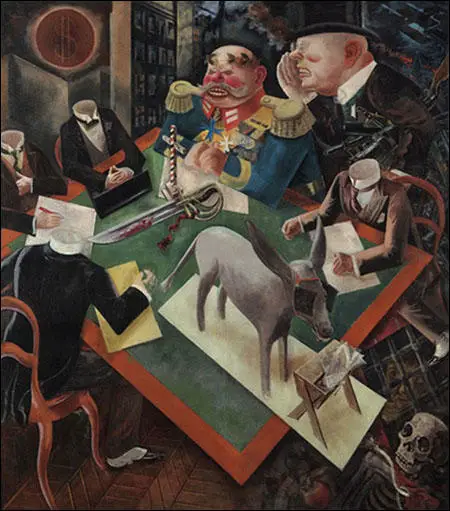
In 1928 Grosz was charged with blasphemy. During his trial he said: "It is a long German tradition which I carry on. When the times are very troubled, when the foundations are shaken, the artist cannot stand aside, especially not the talented artist with his greater sensitivity. That is why, without wanting to, he will be political... There is much injustice and it is a certain inner compulsion which has driven me to the side of those who are struggling against this injustice. I think there is too much brutality and not enough love. Wherever one turns, there are empty words, injustice and brutality. Surely there exists a minority which feels that too. To tell the truth, these feelings are alive, they animate any man who is of a satirical turn of mind." (41)
Grosz also designed sets or costumes for seven productions at Berlin theatres including those of Erwin Piscator. Grosz wrote in his journal that "Erwin has created a great new era for the graphic artist to work in, a veritable graphic arena, more tempting for graphic artists of today than all that stuffy aesthetic business or the hawking around of drawings in bibliophile editions for educated nobs... What a medium, though, for the artist who wants to speak to the masses, purely and simply. Naturally a new area requires new techniques, a new clear and concise language of graphic style - certainly a great opportunity for teaching discipline to the muddleheaded and confused!" (42)
It has been argued that Grosz became one of the most important artists in the world during this period: "Grosz's work as graphic artist, painter, and designer of costumes and stage sets, along with his involvement as co-founder and advocate of new artistic movements, teacher, writer, and political commentator, all underline his versatility. At the centre of his oeuvre, however, stand his political, critically-engaged drawings; it is through them that Grosz became famous... For long phases within his creative output, Grosz saw himself less as an artist than as an aggressive pictorial journalist." (43)
Adolf Hitler
George Grosz, along with John Heartfield and Karl Arnold, were the first artists to realise the dangers of Adolf Hitler. Originally drawn in 1923, but not published until 1930, Hitler, the Saviour, is a change in style for Grosz: "Drawn in the year of Hitler's failed putsch in Bavaria in 1923, told a different story. Grosz's Hitler is a more human figure but divided against himself... who had a necklace of teeth around his neck and wore a furry shift, would not have plastered his hair down so carefully, and cut his moustache in such an odd way. There was a smug and belligerent expression on Hitler's face, an expression which should not have been on the face of one of the heroes of the great German myth... There was a dangerous, downward curve about Hitler's mouth. Grosz was pointing out Hitler's mysticism and its underlying banality, in a way only possible for someone who was familiar with the phenomenon, having observed it closely in its own setting." (44)
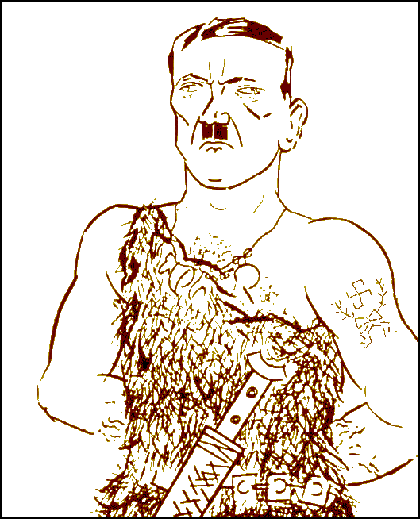
In 1930 Grosz illustrated The Three Soldiers, a children's book by Bertolt Brecht. "The soldiers realised 'that it was a war of the rich and the rich made war only in order that the rich should grow still richer'. The soldiers were called Hunger, Disaster and Disease. They travel across the country, killing as they go along. When they get to Moscow they are shot because there people are unwilling to put up with wretchedness." (45)
Grosz continued to grow worried about the growth in the Nazi Party: "Perhaps what lies ahead of us is the new Middle Ages. At least to me humanist ideas seem to be dying out, just as... human rights are no longer greatly valued. Rather it would appear that hand in hand with the progress of civilisation goes a sound contempt for human life." (46) However, most Germans dismissed Grosz’s anti-Nazi work as hyperbolic and offensive to Christianity, a feeling that far-right activists exploited to distract from what he was saying. One night in the early 1930s, Grosz discovered an iron pipe at his front door with a note attached. “This is for you, you old Jew-Pig, if you keep going with what you’re doing." (47)
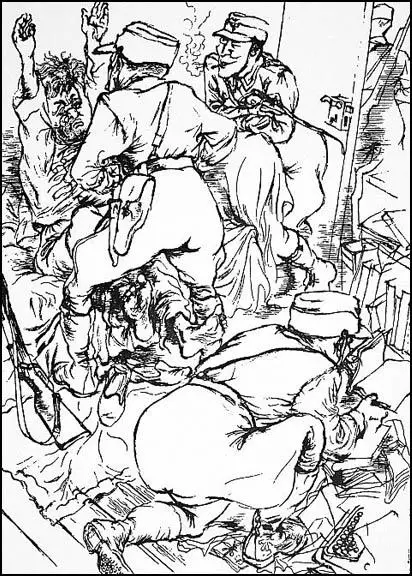
In June 1932, he accepted an invitation to teach the summer semester at the left-wing Art Students League in New York City . In October 1932, Grosz returned to Germany, but on January 12, 1933, he and his family emigrated to the United States. "On 30th January, 1933, Hitler became Germany's Reich Chancellor... Soon letters arrived from which I learnt that they had been looking for me in my empty flat in Berlin, and also in my studio. I venture to doubt whether I should have got away with my life." (48)
Grosz became one of over 2,500 artists and writers to leave Nazi Germany. Grosz continued to attack Hitler in his work. This includes the drawing, He is a Writer (1933). In this drawing Grosz depicts the SA searching through the belongings of a terrified suspect: "He is a writer", they declare. It has been suggested that Hitler's almost fanatical hatred of intellectuals and the educated middle-class can perhaps be traced to his own academic failure and early rejecting of intellectual discipline." (49)
According to Uwe M. Schneede: "Letters, reports and drawings from his early days in America bore witness to Grosz's fascination with the casualness of the Americans, with their shows, their fashions, the speed of their lives... There are many sketches and drawings in which he registered these fresh impressions, his determined turning to American themes running parallel with a total turning away from the political works he had created in Germany... Grosz wanted to become an American illustrator but he failed in this intention. Cut off from his own culture, he remained an alien in exile who did not quite manage to adapt to his new life." (50)
However, when he heard that his friends in Germany were being arrested and being imprisoned in concentration camps, Grosz once again returned to political themes. In 1934 he produced He was a writer, about the death of Erich Mühsam in Oranienburg Concentration Camp. Another friend, Hans Borchardt, was interned in Dachau Concentration Camp before escaping to America: "The camp seemed to him like some kind of hell where those sharing damnation did not by any means share solidarity. Those strapped up together had become perfectly transparent like gelatine, their screams wrapped round with straw. Altogether things were very quiet there, much quieter than in the real world. Even the sub-machine guns had silencers." (51)
Grosz later wrote: "Many things that in Germany had frozen inside me now began to melt, and in America I discovered once again my delight in painting. Deliberately and with great care I burnt a part of my past... If temporarily I suffered from deep depressions, that had nothing to do with America. It was like some threatening flash of summer lightning, like far-away conflagrations and the smell of blood. I painted these visions of ruins in which the fire was still raging. That was long before the war." (52)
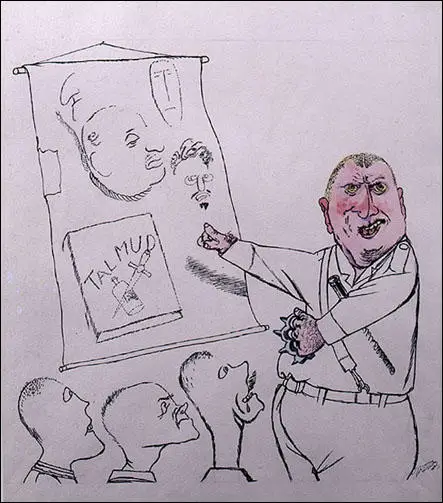
In 1936 a New York publisher brought out a volume of recent Grosz drawings. Several of these dealt with the subjects of the anti-Semitism and anti-Bolshevism of Hitler's government. In one drawing, The Letter to an Anti-Semite (1935), Grosz "shows a teacher demonstrating to his chained pupils a picture of the enemy, a blood-dripping Jewish Bolshevik, while next to it hangs the ideal of the upright German complete with a sword and palm leaf." (53) In 1938 Grosz became an American citizen. (54)
On 27th November, 1936, Joseph Goebbels issued the following decree: "On the express authority of the Führer, I hereby empower the President of the Reich Chamber of Visual Arts, Professor Ziegler of Munich, to select and secure for an exhibition works of German degenerate art since 1910, both painting and sculpture, which are now in collections owned by the German Reich, by provinces, and by municipalities. You are requested to give Professor Ziegler your full support during his examination and selection of these works." (55)
It is estimated that 285 of George Grosz's works were confiscated. Other artists who suffered included Emil Nolde (1,052), Erich Heckel (729), Karl Schmidt-Rottluff (688), Ernst Ludwig Kirchner (639), Max Beckmann (509), Christian Rohlfs (418), Oskar Kokoschka (417), Lyonel Feininger (378), Ernst Barlach (381), Otto Müller (357), Karl Hofer (313), Max Pechstein (326), Lovis Corinth (295), Otto Dix (260), Franz Marc (130), Paul Klee (102), Paula Modersohn-Becker (70) and Kathe Kollwitz (31). The campaign against "degenerate art" took in work by 1,400 artists in all. (56)
The Exhibition of Degenerate Art opened in Munich on 19th July, 1937. It included 650 works of art confiscated from 32 German museums. The exhibition travelled to twelve other cities from 1937 to 1941. In all, the show drew more than 3 million visitors. The exhibition sought to demonstrate the “degeneration” of artworks by placing them alongside drawings done by the mentally retarded and photographs of the physically handicapped. Grosz's work was placed in a section that were considered to be "art as a tool of Marxist propaganda against military service". It was claimed that in these works "German soldiers were depicted as idiots, sexual degenerates and drunks." (57)
An Artist in Decline
It has been argued that after Grosz arrived in America, his importance as an artist went into decline. There are several reasons for this. One concerned his "disappointment about the powerlessness of art in the face of politics". With the success of fascism in Germany made "him aware of the futility of his years of political commitment, particularly against German militarism". Secondly, "yet harder still than this defeat was the suffering which Grosz inflicted upon himself, arising from the boundless hatred which both he and others have diagnosed again and again in his works. For years this hatred was the source of his artistic powers of expression." While living in America he began searching for "new creative impulses - a search that was ultimately to prove futile." (58)
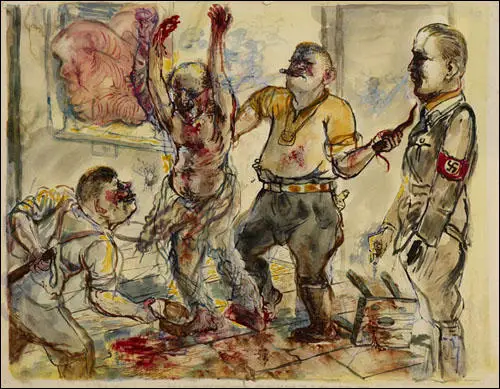
His friend Ernst Toller, also escaped to America. However, he committed suicide in his hotel room in New York City on 22nd May, 1939. "Toller had been found by his secretary, hanging from his bathroom door in a Manhattan hotel. It was said that he must have been thinking of suicide for some time, and that he had had several strange conversations with friends concerning the workings of gas stoves and taps. He had long been suffering from depression; everything seemed to be going wrong for him, and since the Loyalist collapse in Spain he had ceased to be his old self." (59)
In 1946 he wrote: "My pictures are witnesses of my inner world, a world which it is hard to photograph, so that my pictures do not compete with the camera or the newsreel. I create my own fearful fairytale world, full of ruins and populated with ugly dwarfs, frightening superhuman creatures and wicked magicians." (60) The following year he was offered a professorship at the Berlin School of Art. He refusing and told a friend he would rather be poor and a failure in America than a failure and poor in Germany. (61)
George Grosz published his memoirs, The Autobiography of George Grosz in 1955. Grosz returned to Germany in 1959, saying "My American dream turned out to be a soap bubble". A few days later, on 6th July. "after a night out with friends, the inebriated artist slipped on the stairs of his apartment, dying in the hallway from the injuries". (62)
Primary Sources
(1) George Grosz, The Autobiography of George Grosz (1955)
What can I say about the First World War, a war in which I served as an infantryman, a war I hated at the start and to which I never warmed as it proceeded? I had grown up in a humanist atmosphere, and war to me was never anything but horror, mutilation and senseless destruction, and I knew that many great and wise people felt the same way about it.
I don't even like to talk about it. I hated being a number and not merely because I was a very small one. I let them bellow at me for just as long as it took me to find enough pluck to bellow back at them. I stood up as best I could to their disgusting stupidity and brutality, but I did not, of course, manage to beat them at their own game. It was a fight to the bitter end, one in which I was not defending ideals or beliefs but simply my own self.
(2) George Grosz, The Autobiography of George Grosz (1955)
In 1916 I was discharged from military service, or rather, given a sort of leave of absence on the understanding that I might be recalled within a few months. And so I was a free man, at least for a while. The collapse of Germany was only a matter of time. All the fine phrases were now no more than stale, rank printer's in on brown substitute paper. I watched it all from my studio in Sudende, living and drawing in a world of my own.
I drew soldiers without noses; war cripples with crab-like limbs of steel; two medical orderlies tying a violent infantryman up in a horse blanket; a one-armed soldier using his good hand to salute a heavily bemedalled lady who had just passed him a biscuit; a colonel, his fly wide open, embracing a nurse; a hospital orderly emptying a bucket full of pieces of human flesh down a pit.
(3) George Grosz, interviewed by Erwin Piscator (1928)
When John Heartfield and I invented photomontage in my South End studio at five o'clock on a May morning in 1916, neither of us had any inkling of its great possibilities, nor of the thorny yet successful road it was to take. As so often happens in life, we had stumbled across a vein of gold without knowing it.
(4) George Grosz, The Autobiography of George Grosz (1955)
I was recalled (to the German Army) in the middle of 1917. My new duties were to train recruits and to transport and guard prisoners of war. But I had enough and one night they found me semi-conscious, head-first in the latrine. I spent some time in hospitals after that.
Whenever I had a moment to spare I would vent my spleen in sketches of everything about me that I hated, either in my notebook or on sheets of writing paper; the brutal faces of my comrades, badly mutilated war cripples, arrogant officers, lascivious nurses.
(5) George Grosz, The Autobiography of George Grosz (1955)
One day, I gathered that I was to be shot for desertion. Luckily Count Kessler heard about it as well, and interceded on my behalf. In the end, they pardoned me and packed me off to a home for the shell-shocked. Shortly before the end of the war, I was discharged a second time, once again with the observation that I was subject to recall at any time.
(6) George Grosz, The Autobiography of George Grosz (1955)
I thought the war would never end. And perhaps it never did, either. Peace was declared, but not all of us were drunk with joy or stricken blind. Very little changed fundamentally, except that the proud German soldier had turned into a defeated bundle of misery and the great German army had disintegrated.
I was disappointed, not because we had lost the war but because our people had allowed it to go on for so many years, instead of heeding the few voices of protest against all that mass insanity and slaughter.
(7) George Grosz, The Autobiography of George Grosz (1955)
In those days (after the First World War) we were all Dadaists. If the word meant anything at all, it meant seething discontent, dissatisfaction and cynicism. Defeat and political ferment always give rise to that sort of movement.
We held Dadaist meetings, charged a few marks admission and did nothing but tell people the truth, that is, abuse them. The news spread quickly and soon our meetings were sold out, crammed with people wanting to be scandalized or just after fun.
Between insults we performed "art", but the performances were as a rule interrupted. Thus hardly would Walter Mehring begin to rattle away at his typewriter while reciting some piece or other of his own composition, when Heartfield or Hausmann would come out from behind the stage and yell: "Stop! You're not trying to bamboozle that feeble-minded lot down there, are you?"
(8) Mary M. Lane, Time Magazine (18th September, 2019)
Hitler knew that to conquer the wounded hearts of a broken citizenry, he must first conquer culture itself. Dozens of artists faced his persecution when he pushed “Degenerate Art” out of museums and into a derisive exhibition in 1937, but very few tried to warn against it through their work.
One notable exception was George Grosz, a spirited rabble-rouser who risked his career, family, physical safety and mental health to sound the alarm as early as 1923, parodying Hitler’s view of aggressive nationalism in “Hitler the Savior,” a work that mocks Hitler as a Teutonic warrior in a one-shoulder tunic. In his 1926 painting “Pillars of Society,” the then-33-year-old artist warned his fellow Germans that, if petty government sniping and extremist Christianity were not nipped in the bud, Hitler’s rise would be the likely consequence. Grosz further warned against radical far-right religious views in 1927’s “Shut Up and Do Your Duty,” a work that shows Jesus Christ nailed to the cross wearing combat boots and a gas mask - a criticism of politicizing Christianity that drew praise from pacifist Quakers in the United States.
Yet most Germans dismissed Grosz’s anti-Nazi work as hyperbolic and offensive to Christianity, a feeling that far-right activists exploited to distract from what he was saying. Then the death threats began. One night in the early 1930s, Grosz discovered an iron pipe at his front door with a note attached. “This is for you, you old Jew-Pig, if you keep going with what you’re doing.” The artist knew that the reality that he was not Jewish would make scant difference to violent extremists.
After it became clear that the Nazis would be victorious after Hitler was sworn into power in January of 1933, with elections called for two months later, Grosz and his wife Eva fled as persecuted activists to New York, with their two sons, sailing separately to avoid suspicion. He worked tirelessly to integrate and successfully learned both English and the culture of his new country. Yet Grosz still struggled to convince Americans that Hitler’s cultural clampdown was an obvious precursor to stamping out civil rights first for women, minorities and the press—before finally eradicating them for all Germans.
In his 1934 work “Peace,” Grosz foretold that powerful countries would appease Hitler, leading to a Second World War. In the striking black-and-white piece, three cars race down a road, bearing the flags of Imperial Japan, Italy and the Second Spanish Republic. Egging them on is a car brazened with a Swastika.
Grosz created the work a full two years before the Spanish Civil War, three years before the Second Sino-Japanese War, and five years before World War II. It seemed too preposterous to be prophetic, and American culture critics dismissed the piece.
By the time Americans realized Grosz had been right, it was too late.
Decades later, in the spring of 1959, Grosz and his wife Eva moved back to Germany. Eva had been perpetually homesick, and Grosz was seeking emotional closure after years of exhibiting clear signs of trauma. Yet reentry in Berlin was difficult: Grosz had access to even fewer mental health resources than in the U.S.; the art world was in shambles, many of his friends were dead and political chaos continued in Germany with the looming Cold War. Then, on July 6, 1959, after a night out with friends, the inebriated artist slipped on the stairs of his apartment, dying in the hallway from the injuries. With him died his failed dream of warning the world of dictatorship.
So why is Grosz’s heroic story not better known?
In Germany, the reasons are twofold. For most Germans, lauding the risks that Grosz took also involves acknowledging that others - perhaps their parents, grandparents or great-grandparents - enabled Hitler’s rise by not speaking out as the artist did. Secondly, while Grosz was able to escape with some documents that facilitate research, the Nazis destroyed copious works and documents left in Berlin.
Americans, on the other hand, have an uneasy, centuries-old relationship with failure. Millions grew up with the fairytale that if an individual is fighting for what is right, that individual will certainly win and be rewarded for it.
Yet it is critical that we heed Grosz’s warning in our own time: the dismantling of civil rights is portended by the dismantling of culture. It is critical that members of a society recognize that there are times when risking our careers, and even our safety, may be necessary to protect that society’s future.
When others take those risks, the rest of us should pay attention.
